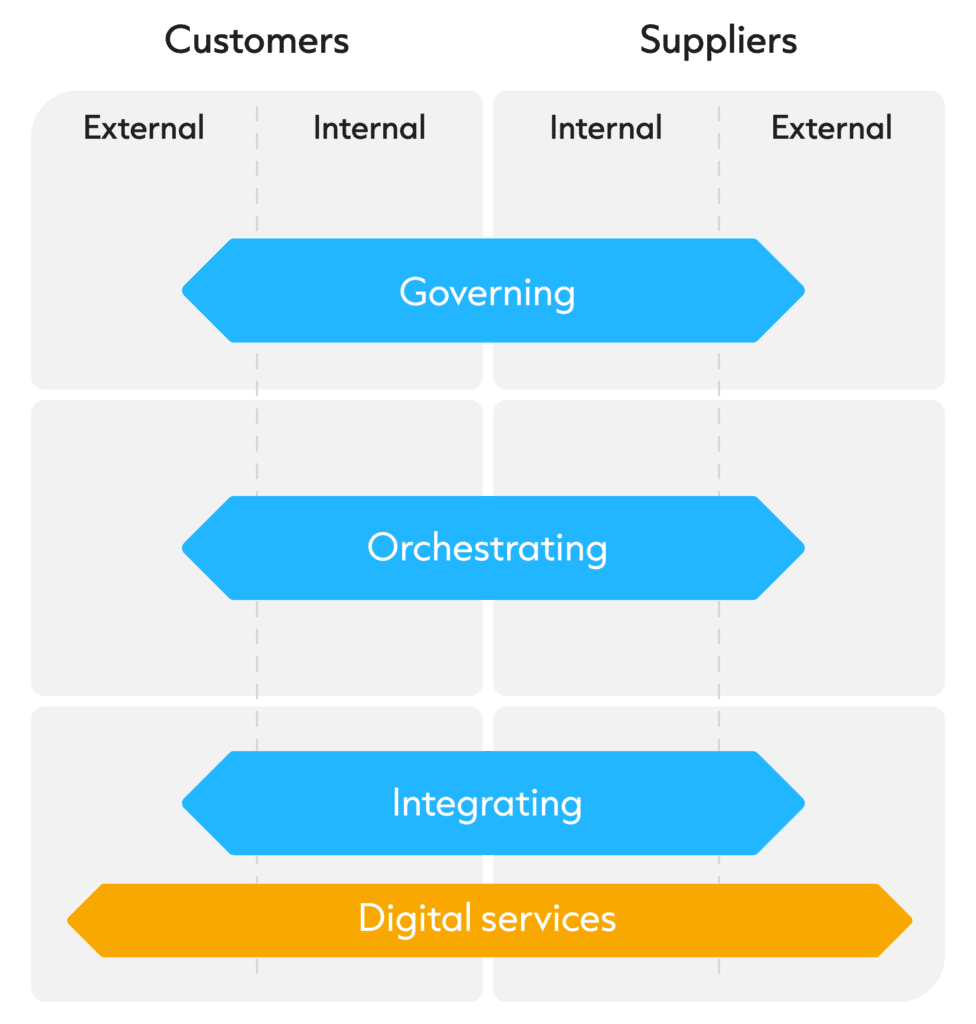To deliver digital services effectively, a balance is needed between developing and running them. After all, what use are services that are not adapted quickly enough to changing circumstances or are changed so often that they can’t be used? That being said, hardly any organizations produce digital services entirely in-house; the use of external (in addition to internal) suppliers is the rule rather than the exception. And digital services are thus increasingly being supplied externally. To handle all this properly, Governance & Management is needed, stresses Ronald Israels.
How can governance & management help strike a healthy balance between developing and delivering digital services? Let’s start by clarifying a few concepts. First of all, the concept of “governance & management” itself. Governance & management entails governing, orchestrating and integrating all stakeholders so that services are delivered in a controlled manner. This allows the customers of the services to use them optimally. The components of governance & management are defined below.
- Governing/governance means drawing up plans, as well as setting and disseminating rules and monitoring compliance with them so that orchestrating and integrating go smoothly. So, governance means setting frameworks and ensuring they actually work in practice. Governing is often referred to as “plan” (as in plan-build-run) or strategic and tactical governance & management.
- Orchestrating/orchestration means having services set up and allowing them to be changed. This can be done through projects or based on scrums. Orchestrating, therefore, means implementing changes to services and realizing new services. It involves build and change management.
- Integrating/integration means putting together services and having operational services delivered. Integration ensures that the services delivered to users are reliable. Integration involves operate or run management.
If an organization has proper governance & management in place, the result is the right mix of secure, reliable, innovative, flexible and affordable services. Governance & management also ensures that run and change are in balance. But how do you achieve this balance?
“That services remain available for too long is a well-known phenomenon.”
Optimizing run costs and reliability through integration
First and foremost, integration must ensure that run costs and reliability are optimized. There are some basic methods for this:
- Make explicit what services are provided to internal and external users, including what users can do with these services and how they can access them. Services that are not known to end-users might as well be done away with.
- Create clear expectations to end-users about the reliability of the services. They usually don’t pay for the services directly (the customer does), but they want to know where they stand and there should be measures in place for them if the services cannot be delivered.
- Make sure the services work end-to-end and ensure the suppliers involved collaborate with each other, if this is not yet the case. Nothing is more irritating to an end user than a service where the various parties involved point to each other when things don’t work or don’t perform as expected.
- Ensure the value of services. It’s a well-known phenomenon that services are created but remain available for too long when they are no longer widely used, are duplicated by other services, or do not work optimally. An important goal of integration is to make known which services can be rationalized and improved to optimize the value-cost ratio.
- Ensure the continuity of services. Digital services need to share an increasing variety of components. All these components must be reliable and sufficiently secure. This is only possible if lifecycle management is performed in a timely manner. Those handling integrations must ensure this, including the costs balance.
- Monitor the efficiency of the delivery and use of the services by, for example, automating management and facilitating self-service.
- Finally, realize that run costs increase when commercial standardized services are used. However, using them also limits change costs and can therefore be beneficial to the organization overall.
Optimizing change costs and value through orchestration
Orchestration must ensure the optimization of the cost of changes as well as the value that is delivered as a result. Here too, a number of rules of thumb apply:
- Develop in short cycles, interacting with users (or their representatives). Gain insight into whether a change will actually deliver something by providing minimum viable products that can be transferred quickly to run. And discard anything that provides no or too little value (this saves on run costs). Realize that building in itself does not provide any value, but putting a build into production might.
- Beware of too many releases. CI/CD (continuous integration and continuous delivery/deployment) can degenerate into trial-and-error work, and ultimately result in unreliable services with features users don’t want.
- Use pre-existing components as much as possible. Cleverly combining APIs, microservices, SaaS, PaaS or if necessary, IaaS, will usually take you a long way.
- Pay-per-use. Make sure services can be used both during development and run on a pay-per-use basis. Paying only for the test server capacity used is efficient. But you can also pay hired staff based on achieved story points.

Overview of governance & management
Optimizing the balance between run and change through governance
Finally, governing ensures there is a balance between run and change. There are several generic methods for this as well:
- Make sure the strategy is clear. This ensures that, in terms of services, you have determined in advance what you will invest in and what you will limit or even stop.
- Split the available money into buckets. Make budgets for managing the various services, carrying out experiments (to be innovative), developing new services, and even for the various forms of maintenance (corrective, preventive, perfective, and adaptive). And finally, spend money on improving working methods and personnel capabilities (through training and learning).
- Know and communicate internal and external rules for things like security, privacy, integrity, and finance – and monitor compliance with them. Scrum teams and the service desk must also know these rules and be able to apply them, otherwise, they will not work.
- Manage the risks. Many of the rules require balancing risk and risk appetite, meaning not everything has to be done perfectly. Run can cost a lot of effort if the focus is on minimizing risks. Bear in mind the quote: “If everything’s under control, you’re going too slow” (Mario Andretti).
- Ensure collaboration between all parties. As mentioned earlier, there are many internal and external players involved in run and change. Make sure they collaborate, and you ensure optimal value.
- Make timely decisions based on short- and long-term goals. Perhaps the essence of governance & management is making the right choices at the right time.




